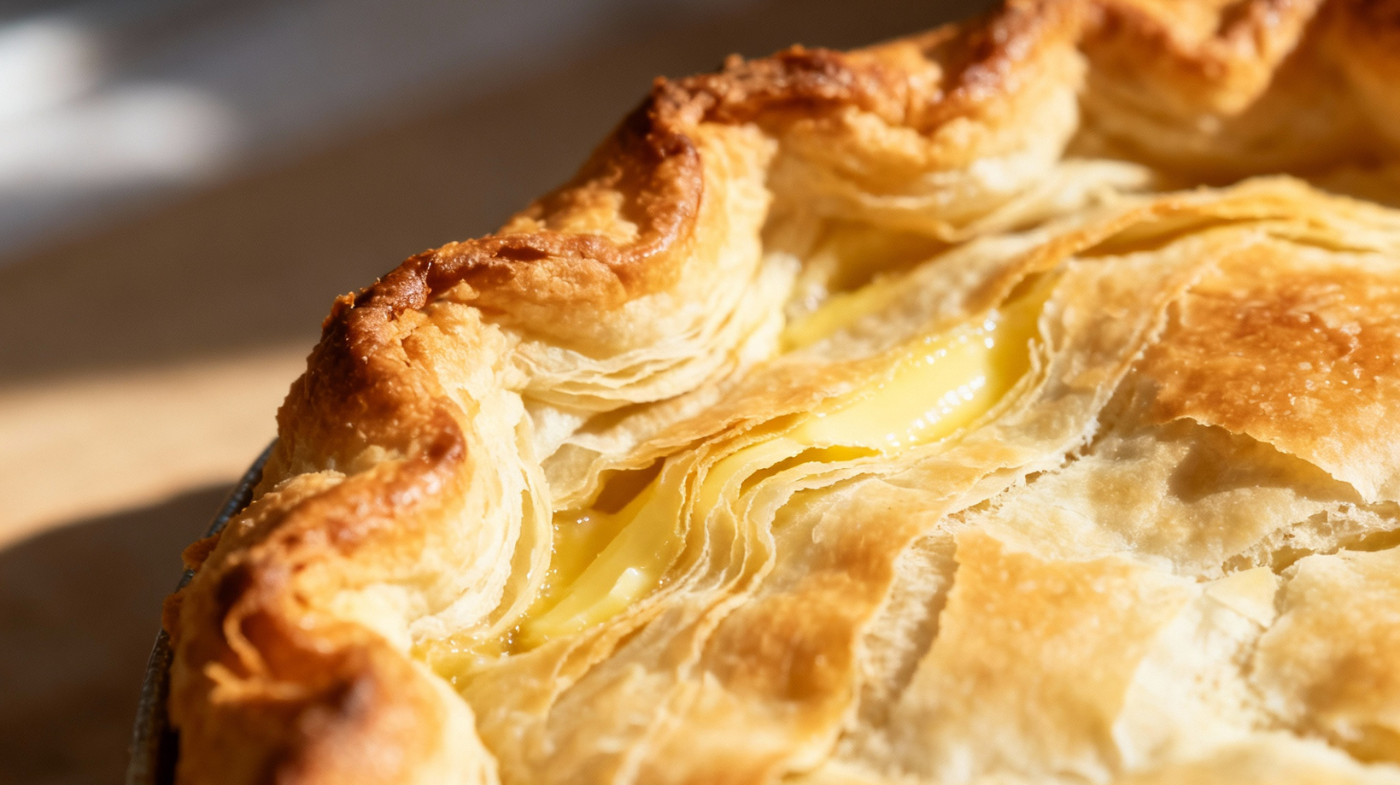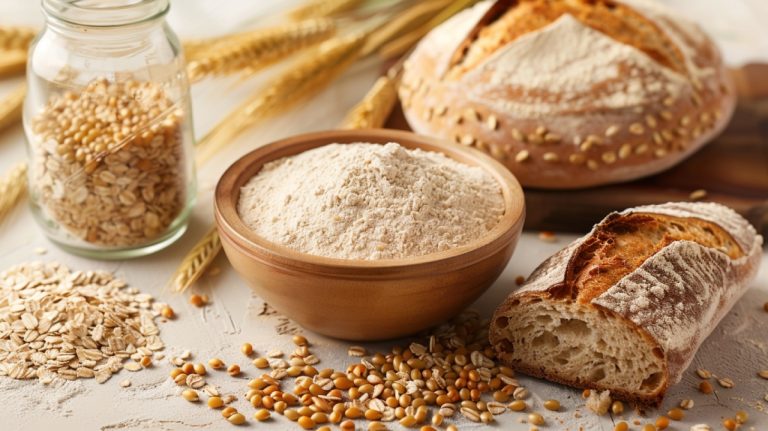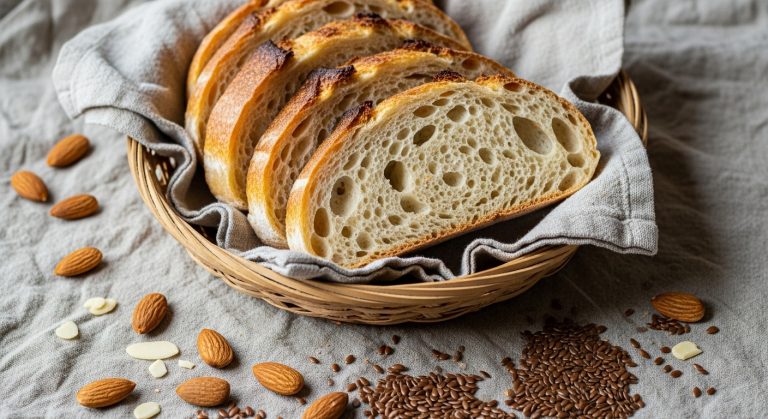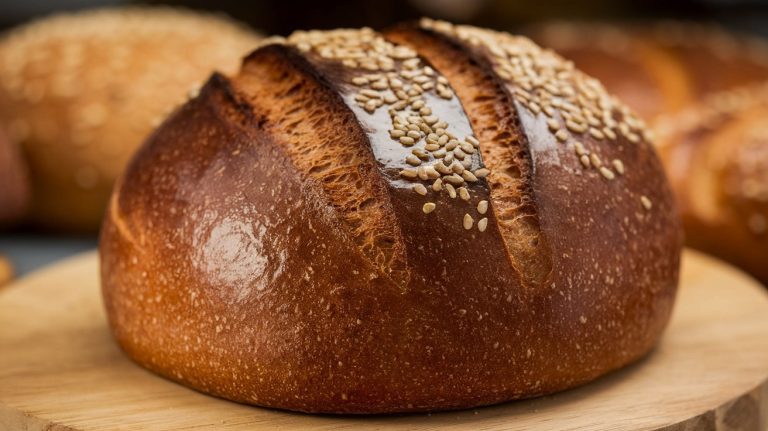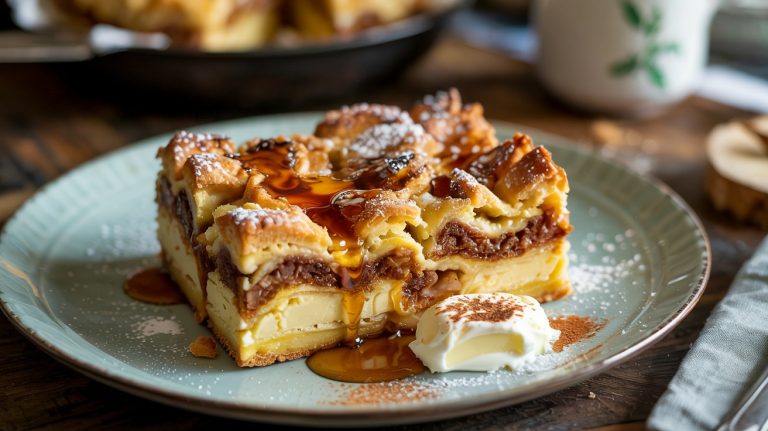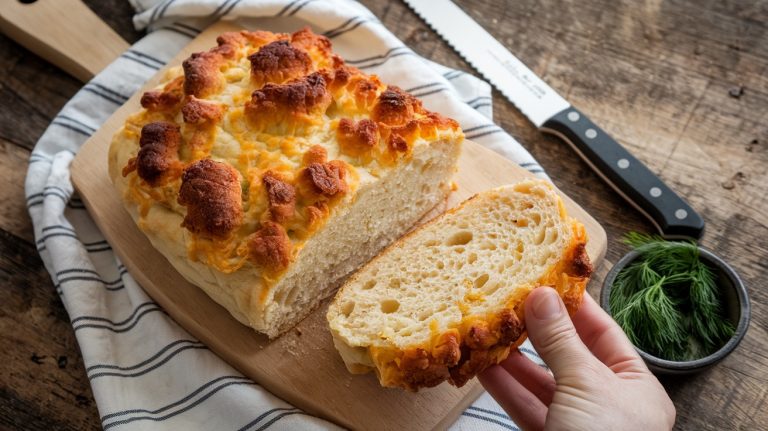Sourdough Pie Crust Recipe: Master the Flakiest Crust
You’ll love making a sourdough pie crust that’s flaky, tangy, and buttery. Start by mixing flour, salt, and sugar, then cut in cold butter until it looks like peas.
Gently fold in your cold sourdough starter, adding water if needed, and chill the dough for at least two hours. This resting step helps develop flavor and texture.
Baking starts hot to set layers, then lowers for a golden finish. Keep going to discover expert tips for flawless crust every time.
Key Takeaways
- Combine 1.5 to 2 cups all-purpose flour, 1 cup cold sourdough starter, 1 teaspoon salt, and 1 tablespoon sugar for the base dough.
- Cut 1 cup cold, cubed butter into flour mixture until pea-sized pieces form for a flaky texture.
- Gently mix in sourdough starter and add cold water if needed, then chill dough discs for 1-3 days to develop flavor.
- Roll dough to 1/8-inch thickness, chill before baking, and blind bake at 350–375°F with pie weights for a crisp crust.
- Start baking at 400–425°F for 10–15 minutes, then reduce to 350–375°F to finish, using a pie crust shield to prevent overbrowning.
Essential Sourdough Pie Crust Recipe Ingredients & Instructions
| Component | Details | Purpose & Tips |
|---|---|---|
| All-Purpose Flour | 1.5 to 2 cups | Provides ideal protein content for tenderness and structure; use accurately measured flour for best results |
| Sourdough Starter/Discard | 1 cup (100% hydration) | Adds tangy depth and moisture; use cold discard straight from refrigerator for flakiest layers |
| Cold Unsalted Butter | 1 cup (cubed or grated) | Creates flaky layers through steam pockets; keep cold to prevent early melting |
| Salt | 1 teaspoon | Brightens flavors and enhances overall taste; essential for flavor balance |
| Sugar | 1 tablespoon | Helps browning and controls gluten development; reduce or omit for savory pies |
| Ice Water | As needed (1-2 tablespoons) | Adjusts dough consistency; add teaspoon by teaspoon to avoid over-hydration |
| Optional Add-ins | Honey or lemon juice | Enhances sweetness and acidity for complex flavor profiles |
| Mixing Method | Combine dry ingredients first | Ensures even flavor distribution before adding fats |
| Butter Incorporation | Cut until pea-sized pieces | Creates visible butter chunks for maximum flakiness |
| Dough Assembly | Mix gently to shaggy mass | Prevents tough gluten formation; handle minimally |
| Chilling Time | 2 hours minimum (up to 3 days) | Develops flavor and texture; allows gluten to relax and fats to solidify |
| Baking Temperature | Start 400-425°F for 10-15 min | Sets crust quickly; then reduce to 350-375°F for golden finish |
| Blind Baking | 350-375°F for 20-30 minutes | Use pie weights and parchment; bake until edges are golden |
| Storage Options | Refrigerate 3-4 days or freeze 3 months | Wrap tightly; thaw overnight in refrigerator for best texture |
Ingredients Needed for The Pie Crust
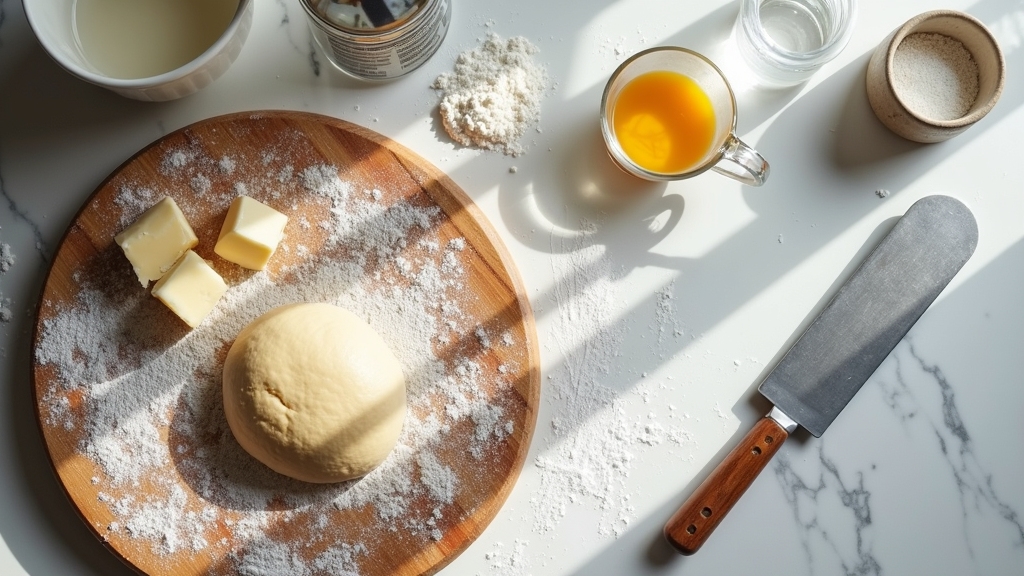
To craft a perfect sourdough pie crust, you’ll need a handful of key ingredients that balance flavor, texture, and structure.
Start with 1.5 to 2 cups of all-purpose flour, chosen for its ideal protein content to offer both tenderness and strength.
Add 1 cup of sourdough starter or discard at 100% hydration, which brings tangy depth and moisture. It’s best to use cold sourdough discard straight from the refrigerator for flaky layers. Using sourdough also contributes to a lower glycemic index, making the crust a healthier option.
Incorporate 1 cup of cold, unsalted butter, cubed or grated, to guarantee flaky layers without early melting.
Season with about 1 teaspoon of salt to brighten flavors, and a tablespoon of sugar to help browning and control gluten development.
Reduce or omit sugar for savory pies. Optional touches like honey or lemon juice can enhance sweetness and acidity, while ice water adjusts dough consistency.
Using cold ingredients keeps your crust flaky and easy to work with.
Preparing the Dough Step-by-Step
When you start preparing the dough, begin by thoroughly mixing the dry ingredients: flour, salt, and sugar, so their flavors distribute evenly before adding the butter.
Use chilled, cubed butter, cutting it into the flour mixture until pea-sized pieces remain visible. This helps create a flaky texture.
Coat the butter with flour to delay melting.
Next, add cold sourdough starter, mixing gently with a fork or pulsing briefly in a food processor before finishing by hand. The recipe typically uses 1 cup sourdough starter for best results.
Bring the dough together into a shaggy mass without overworking it to avoid toughening. If it feels dry, add cold water teaspoon by teaspoon.
Shape the dough into discs about 1–2 inches thick for chilling. Divide the dough into two discs, wrap with plastic, and chill for 1-3 days or longer to develop flavor and texture.
Properly preparing the dough sets the foundation for a tender, flavorful crust.
Techniques for Achieving Flaky Texture
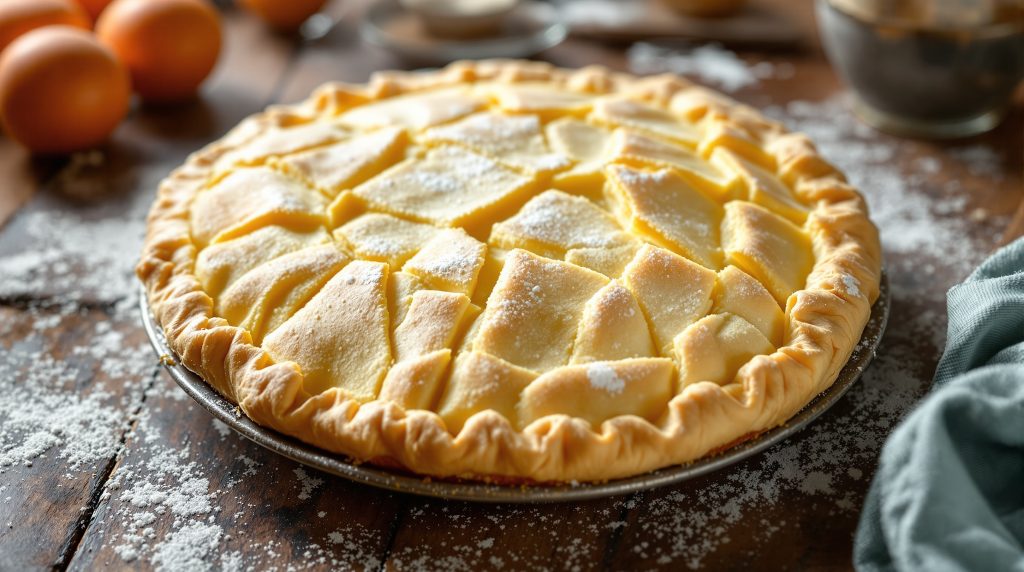
Although it might seem simple, achieving a flaky pie crust demands careful attention to ingredient temperature, handling, and hydration. You need cold butter and chilled water to keep fats solid, creating steam pockets that lift flaky layers during baking. Using a digital baking scale can help ensure precise measurement of these ingredients for consistent results.
Minimal mixing prevents tough gluten from forming, so mix just until combined. Managing hydration keeps the dough firm yet tender, avoiding sogginess. Resting the dough lets gluten relax and fats solidify, enhancing texture. Using the sourdough starter discard can add complex flavor and contribute to a tender, flaky texture.
Use cubed cold butter, pulsing briefly for pea-sized lumps. Add just enough chilled liquid to bind the dough. Rest dough 2+ hours in the fridge before rolling.
Roll gently to 1/8-inch thickness, chilling again before baking. These steps lock in flaky layers, giving your sourdough crust irresistible crispness.
Baking Tips and Temperature Guidelines
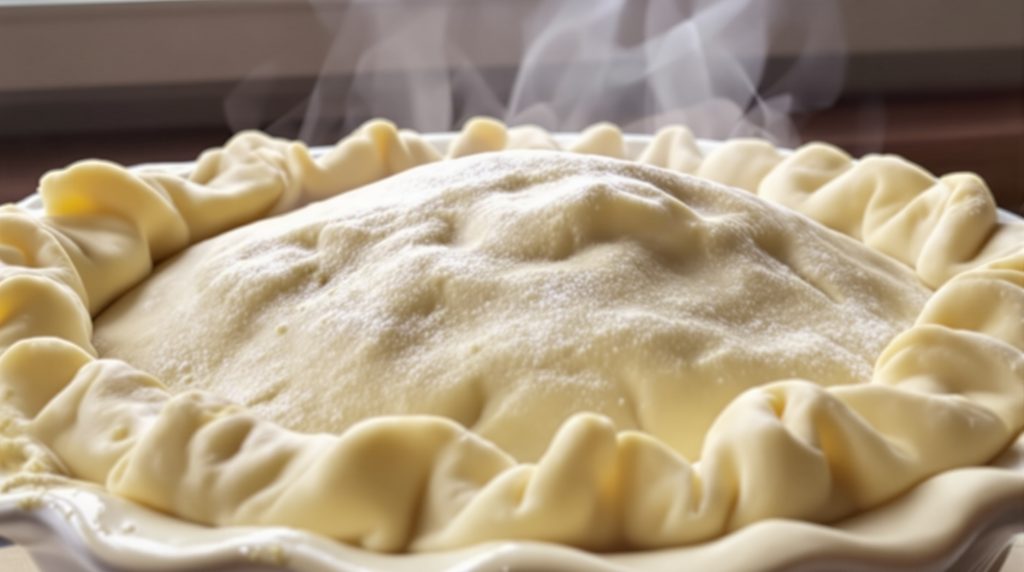
Mastering the baking temperature is essential for your sourdough pie crust to achieve that perfect balance of golden crispness and tender flakiness.
Start by baking at a high temperature, around 400–425°F for 10–15 minutes, to help the crust puff up and set quickly. Then, reduce the heat to 350–375°F to finish baking evenly without burning.
If blind baking, chill the crust first, line it with parchment, and use pie weights to keep it flat. Bake blind at 350–375°F for 20–30 minutes until edges turn golden, then cool before filling.
Remember, adjusting baking times depending on your filling is key, and using pie crust shields can protect edges from overbrowning.
Keeping dough cold and rolling it evenly will also help your crust bake perfectly.
For the most consistent results, consider using a baking thermometer to ensure your oven maintains the ideal baking temperature accuracy.
Storing and Handling Your Pie Dough
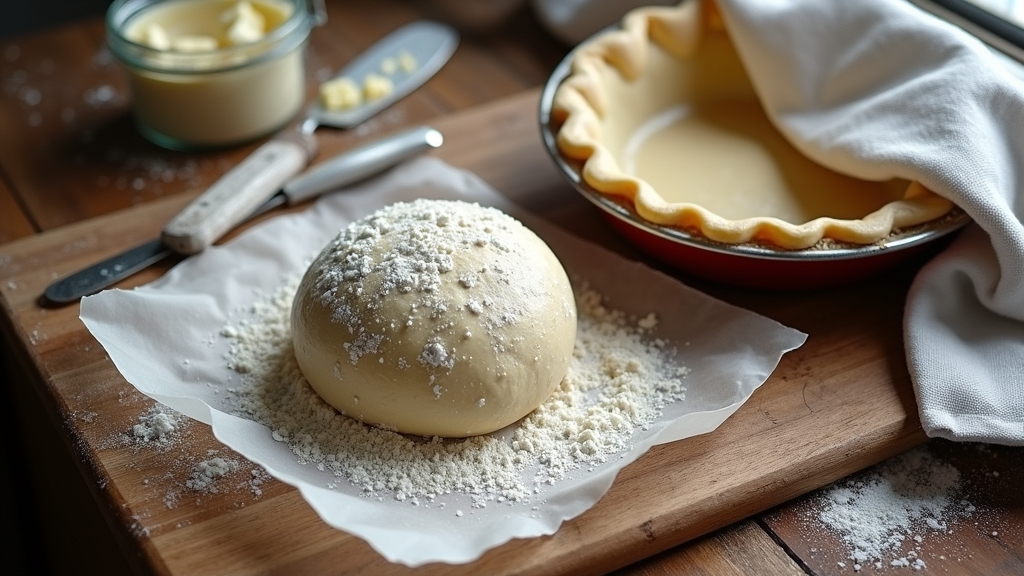
Since sourdough pie dough is delicate and alive with yeast activity, proper storage and handling are essential to maintain its texture and flavor.
Sourdough pie dough’s delicate yeast activity demands careful storage to preserve its texture and flavor.
You’ll want to shape your dough into a disc or rectangle, then wrap it tightly in plastic wrap or an airtight container before refrigerating. Chill it for at least two hours to make rolling easier and keep the dough’s structure intact. Using frozen butter in the dough helps achieve a flaky texture. Extended cold fermentation can also enhance acetic acid development, contributing subtle tang to the crust.
When you’re ready to bake, let it rest briefly at room temperature and roll gently on a floured surface.
Refrigerate dough up to 3-4 days, or freeze tightly wrapped for up to 3 months.
Thaw frozen dough overnight in the fridge to avoid cracking.
Use parchment to roll and store dough for quick unrolling later.
Blind bake directly from frozen if frozen in pie pans for convenience.
Frequently Asked Questions
Can I Use Sourdough Starter Discard Instead of Active Starter?
Yes, you can definitely use sourdough starter discard instead of an active starter. It won’t change your pie crust’s texture or flavor much, and it’s a great way to reduce waste.
The discard adds a subtle tang and helps create a tender, flaky crust. Just keep it cold and mix gently to keep those butter chunks visible.
Plus, discard is convenient since you can store it in the fridge for a couple of weeks before baking.
How Does Sourdough Fermentation Affect Pie Crust Flavor?
Sourdough fermentation brightens your pie crust’s flavor like a splash of lemon in a rich sauce. It adds a tangy depth and subtle complexity that you won’t get from regular dough.
The natural acids and bacteria gently tweak the taste, creating a mild sourness balanced with savory, almost umami notes.
This process also enhances texture, making your crust flakier and more tender, giving every bite a delightful, nuanced zip.
What Is the Best Way to Thaw Frozen Sourdough Pie Dough?
The best way to thaw frozen sourdough pie dough is to move it from the freezer to your refrigerator and let it thaw slowly overnight, usually 12 to 24 hours.
This gentle thaw preserves texture and flavor. Once thawed, let it sit at room temperature for about 30 to 60 minutes until it’s pliable.
If it still feels firm, gently tap it with a rolling pin to soften before rolling out.
Can I Substitute Butter With Shortening or Lard in Sourdough Crust?
Yes, you can substitute butter with shortening or lard in your sourdough crust.
Shortening offers a more stable texture and less greasy feel but lacks butter’s rich flavor.
Lard may provides tender, flaky results but doesn’t deliver the buttery taste you might expect.
Keep in mind, these swaps may require slight adjustments to chilling and mixing to get the perfect flaky, tender crust you want.
How Long Can Baked Sourdough Pie Crust Be Stored at Room Temperature?
You can keep your baked sourdough pie crust at room temperature for up to 2 days. Any longer, and it’ll start to lose its crispness faster than a superhero loses their cape!
To maintain that perfect texture, store it in an airtight container, shielding it from air and humidity.
Beyond two days, refrigerate or freeze it to keep it fresh and prevent it from turning stale or soggy.
Your Sourdough Starter Has a New Purpose
Now that you’ve mastered your sourdough pie crust, you’re part of a growing trend. Over 60% of home bakers say using sourdough starter adds unbeatable flavor and flakiness.
With your flaky, tangy crust ready, you’ll elevate every pie you bake. Remember, patience and gentle handling make all the difference.
Store your dough properly, and you’ll enjoy perfect crusts again and again, turning simple ingredients into irresistible homemade delights.

